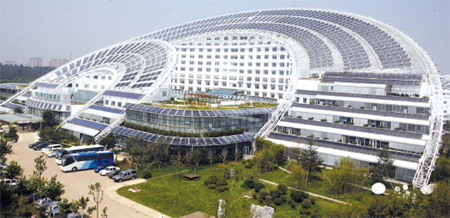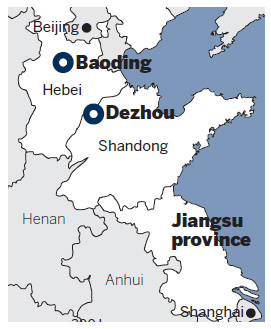Economy
Rise and shine
Updated: 2011-03-25 13:08
By Meng Jing (China Daily European Weekly)

Himin Solar's headquarters, known as the Sun-Moon Mansion, in Dezhou, Shandong province, is considered one of the largest solar-powered office buildings. Er Dong / for China Daily |
Chinese authorities recently announced plans to suspend the approval of new nuclear power plants, including those under construction, following the nuclear crisis in Japan. Existing Chinese nuclear plants will also be come under a safety review. The news came amid expectations that the crisis will cause a setback to the nuclear sector inside and outside of Japan, which was hit by a magnitude-9 quake and tsunami on March 11 that damaged its nuclear plant in Fukushima prefecture.
But stocks in alternative and clean energy sectors such as solar energy soared following the announcements, even as Chinese companies in the nuclear energy sector saw their shares fall.
Investors are not the only ones betting on a solar energy boom in China - cities nationwide have been rushing to label themselves as "solar cities" or pledging to establish themselves in the past one to two years.
The solar city fever has spread from Baoding in northern Hebei province to Xinyu in eastern Jiangsu province, and even reaching Dunhuang in inland Gansu province, as the global solar power installation recorded massive expansion in 2010.
Global solar photovoltaic (PV) installation capacity - which uses PV technology to generate power from the sun's rays - reached 40 gW in 2010, almost double its figure of the previous year, says the European Photovoltaic Industry Association. However, China only recorded 0.4 gW of new installation in 2010 while its European counterparts clocked in 13 gW of new installations.
To catch up with the rapid pace of solar energy installation worldwide and cut back on its greenhouse gas emissions, China is expected to boost its installed capacity of solar generation by more than 60 times to about 20gW by 2020, according to the Ministry of Science and Technology.
|
|
The central government also announced plans to build 100 new "energy demonstration cities" during its 12th Five-Year Plan (2011-2015).
The huge business potential in the international and domestic markets as well as the incentives for a greener environment have lured many local governments.
The China Renewable Energy Association estimates that nearly 100 self-claimed solar cities in various types and sizes have been mushrooming in China.
"Most of them want to nurture their PV manufacturing industry by promoting solar-generated power locally," says Meng Xian'gan, vice-chairman of the China Renewable Energy Association.
"However, applying solar technology city-wide is a complicated and systematic process, requiring a long-term plan," he says. "Those cities which install one or two solar power lamps or put some solar PV panels on rooftops are not qualified to be called solar cities."
There is no national standard on the type of city that can be labeled "solar". But Meng set a high standard himself, saying that about 20 percent of the power used in the city should be generated by solar energy.
By his standard, cities in China still have a long way to go.
The cost of solar-generated power remains much higher than fissile fuel power, which cannot be used in China without government subsidies. Even when the price drops to a reasonable range, connecting solar-generated power to the power grid and maintaining a stable supply are still challenges.
In the race for solar supremacy in the country, three front-runners - either leaders in solar cell manufacturing or in the use of solar technology - shine through to give a peek at the future of Chinese solar cities.
Specials

In the swim
Out of every 10 swimsuits in the world, seven are made in China.

Big spenders
Travelers spend more on shopping than food, hotels, other expenses

Rise in super rich
Rising property prices and a fast-growing economy have been the key drivers.
